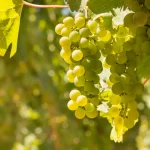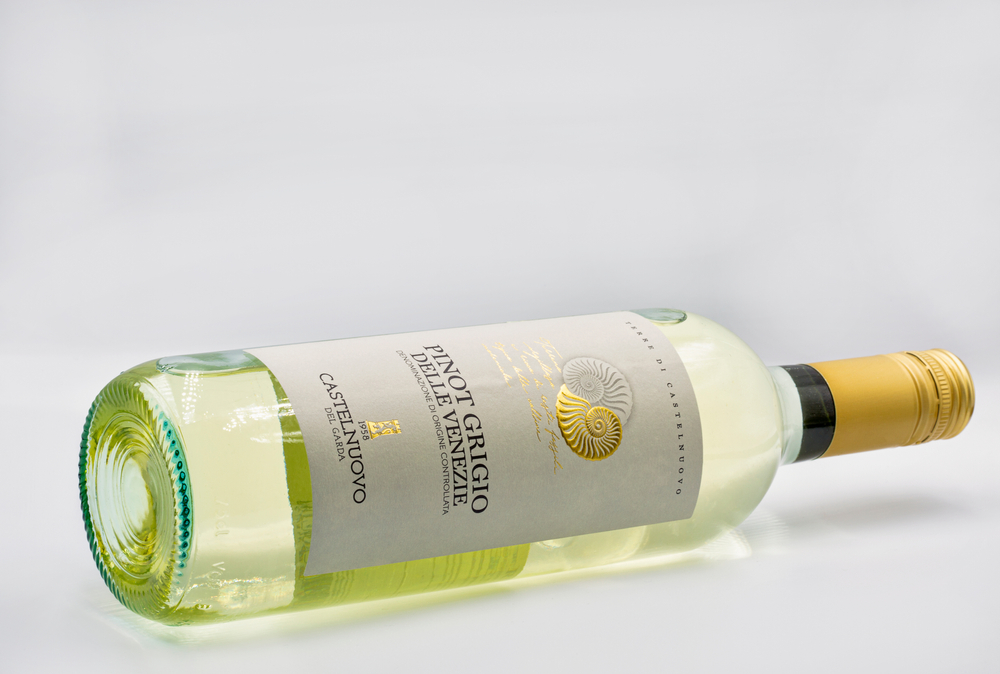When getting into white wines, it is very easy to get overwhelmed by the many excellent, different options on the market today. For example, choosing between Chardonnay, Pinot Grigio, and Sauvignon Blanc will challenge just about anybody and require a careful approach.
If you’re interested in any of these three wines, please read more to get the inside scoop.
Then, we’ll compare these three wines and give you a look at a few other white wine options that may also suit your taste as a wine beginner.
Handy Tip: Pinot Grigio, Chardonnay & Sauvignon Blanc are excellent white wines for cooking.

7 Popular Types of White Wine
Before we explore and compare these three wine types, it is a good idea to take a brief look at the seven popular types of white wine available to you. An in-depth guide for these 7 is available, too.
First, we’ll just briefly highlight a few different things about each option to give you a feel for why they might be right for you.
Then, we’ll get into the nitty-gritty of this article and help you decide between Chardonnay, Pinot Grigio, or Sauvignon Blanc.
Chardonnay
Chardonnay is one of the most popular white wines on the market and is made either with oaked or unoaked methods.
As a result, Chardonnay is typically a relatively dry wine with a medium body containing hints of fruit, spice, and butter.
Depending on the brewing method and how long the grapes ferment before bottling, other types may be somewhat creamy or acidic.
Pinot Grigio
If you’re a wine newbie or have only just started with wine, there’s a good chance that you’ve probably already tried Pinot Grigio.
This wine is the second most popular white wine on the market and tends to be reasonably dry to off-dry.
You’ll get a nice note of pear and mineral when drinking this wine and should find it fairly refreshing. Some people like the slightly fruity aftertaste typical with this wine, too.
An added benefit is that it tends to be lower in calories compared to a lot of other wines.
Sauvignon Blanc
Sauvignon Blanc is a somewhat late arrival on the white wine scene but has made up for a lot of lost time.
Its surprisingly delicious taste is broad because creators use many different brewing methods. As a result, you can anticipate fruity, herby, and even earthy Sauvignon Blanc wines.
Surprisingly, the zesty punch of this wine remains a constant despite this diverse taste profile.
Moscato
Moscato white wines are typically one of the sweeter options and have a pretty unique array of flavors.
You can anticipate a little orange blossom, stone fruit, and even citrus undertone with this wine.
They utilize the Moscato grape, which authentically must be grown in Piedmont, Italy.
However, Moscato wines are produced using grapes from all over the world, focusing on muscat varieties.
Riesling
German white wine, Riesling, is another popular option that often ages very well.
It is available in both very dry and sweet options, meaning that you can use it for a nightcap or a dessert wine.
They contain a somewhat aromatic texture and minerals, earth, and petrol hints. They also have a pretty dense floral note, making them a good option for many wine fans.
Checkout our comparison of Riesling vs Chardonnay for yourself.
Gewürztraminer
Gewürztraminer may not be a name that rolls easily off the tongue but it is a relatively popular European wine.
While not massive in America, it compares favorably to many American wines and is a reasonably tasty option.
You’ll get a surprising taste profile when taking your first sip: some people report cinnamon and nutmeg, while others taste clove or rose petal aftertastes.
Checkout our comparison of Riesling vs Gewurztraminer for yourself.
Sémillon
A Semillon wine is a simpler and purer white wine on the market, holding a reasonably full-bodied taste with a fruity or herbal hint.
They typically contain a relatively high acidity and low alcohol content, making them a little sweeter than other white wines.
These wines may not have the name-brand recognition of different types, but should work well for those who need alternative options.
Pinot Grigio vs Sauvignon Blanc vs Chardonnay
In the following few sections, we’ll compare Pinot Grigio to Sauvignon Blanc and then Chardonnay and Sauvignon Blanc to make your purchasing decision a little easier.
After that, we’ll discuss many different elements about each wine, including its grapes, growing region, food pairings, and more.
It would help if you were pretty comfortable choosing any of these options when you finish reading this article.
Deeper Dive: Pinot Grigio vs Sauvignon Blanc
Pinot Grigio and Sauvignon Blanc wines come from French grapes with pretty broad taste profiles and look.
They may seem pretty simple at first but can be surprisingly variant, based on your overall preference and much more.
So let’s take a deeper dive into these unique wines to understand better which is the best option for you and which might not work for you at all.
Pinot Grigio Grapes Compared to Sauvignon Blanc Grapes
First, let’s get the obvious out of the way: Pinot Grigio and Sauvignon Blanc grapes both originate in France. That fact is vital because these grapes have some of the oldest wine-making histories.
However, they ultimately look pretty different and produce a variety of different tastes.
First, Pinot Grigio grapes became famous not from French winemakers, but Italian ones.
Italian winemakers wanted to create a simple and easy-to-drink wine and chose Pinot Grigio grapes, which have a reasonably dusty or grayish skin: Grigio means “gray” in Italian, appropriately enough.
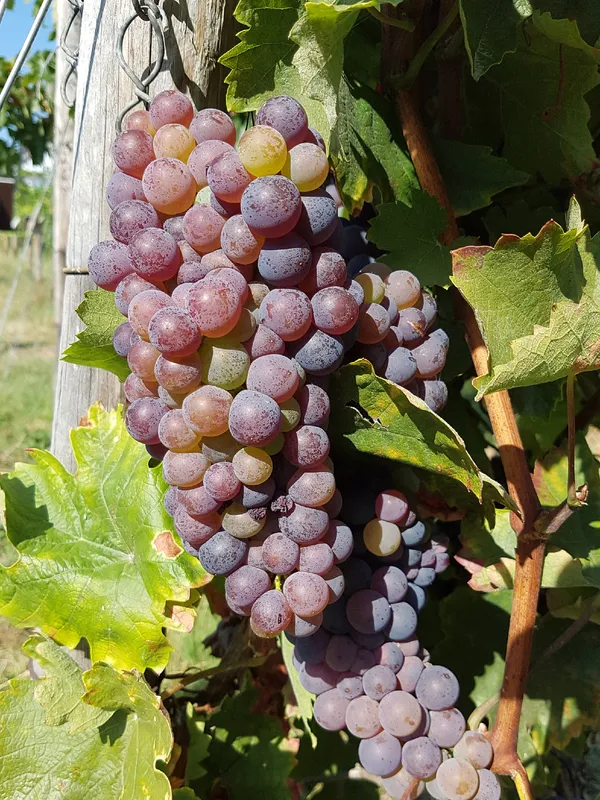
By contrast, Sauvignon Blanc grapes are relatively densely clustered and have a bright green look and color.
They often ripen much earlier than Pinot Grigio grapes, meaning they must be harvested quicker.
Most Sauvignon Blanc grapes are rounder and fuller than Grigio grapes.
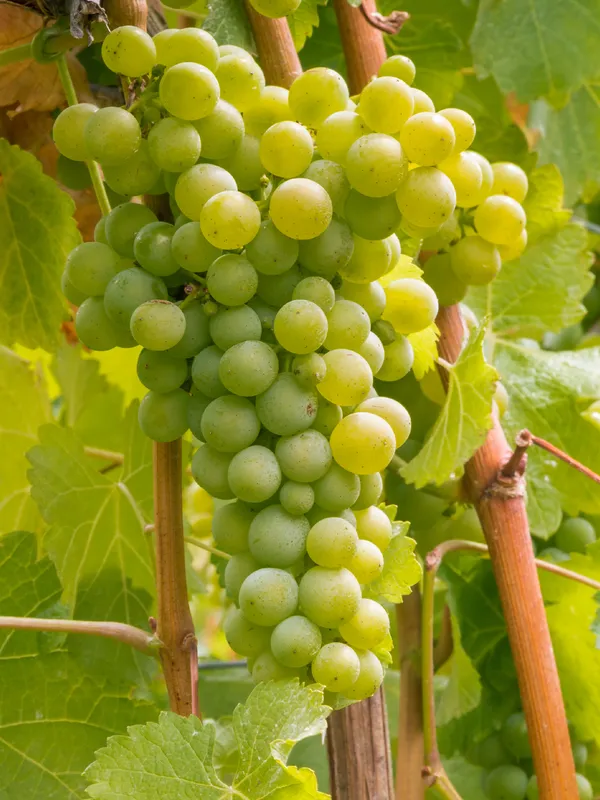
What is important to remember, is that the grape growing region influences taste and much more.
That’s because the earth itself and various growing methods can affect grape texture and taste. Let’s examine this fact in more depth in the next section to give you a better understanding.
Pinot Grigio Region vs Sauvignon Blanc Region
Sauvignon Blanc and Pinot Grigio grapes are grown throughout many different world regions.
For example, Pinot Grigio is commonly grown in Italy, Austria, California, Germany, and France.
By comparison, Sauvignon Blanc is common in New Zealand, Australia, Chile, South Africa, California, and France.
So, while these two grape types share a few growing regions, they don’t share quite a few places.
Typically, Sauvignon Blanc does better with cooler climates and sandier soils and has thrived perfectly in places like New Zealand, which usually has more severe temperatures and environments.
By contrast, Pinot Grigio usually does better in warmer temperatures, such as throughout the northern regions of Italy.
You typically find it in Lombardy, Veneto, and Friuli who have relatively affluent soil options. These changes affect how well the grapes ferment and impact taste in many ways.
For example, warmer-temperature grapes may mature more quickly and produce less sugar than colder-temperature grapes that grow and develop longer.
The overall taste and style preference will depend on you, so make sure you try a few glasses before deciding here.
Pinot Grigio Food Pairings vs. Sauvignon Blanc Food Pairings
Pinot Grigio food pairings typically require a more subtle and gentle texture, as the flavor of the food might ironically overwhelm your delicate Pinot.
In addition, you usually don’t want to pair it with hearty or meaty dishes, as they often don’t compliment each other well and may become a bit overwhelmed.
Instead, you may find yourself pairing your Pinot with fish and seafood, as it goes particularly well with shellfish like shrimp or crabs.
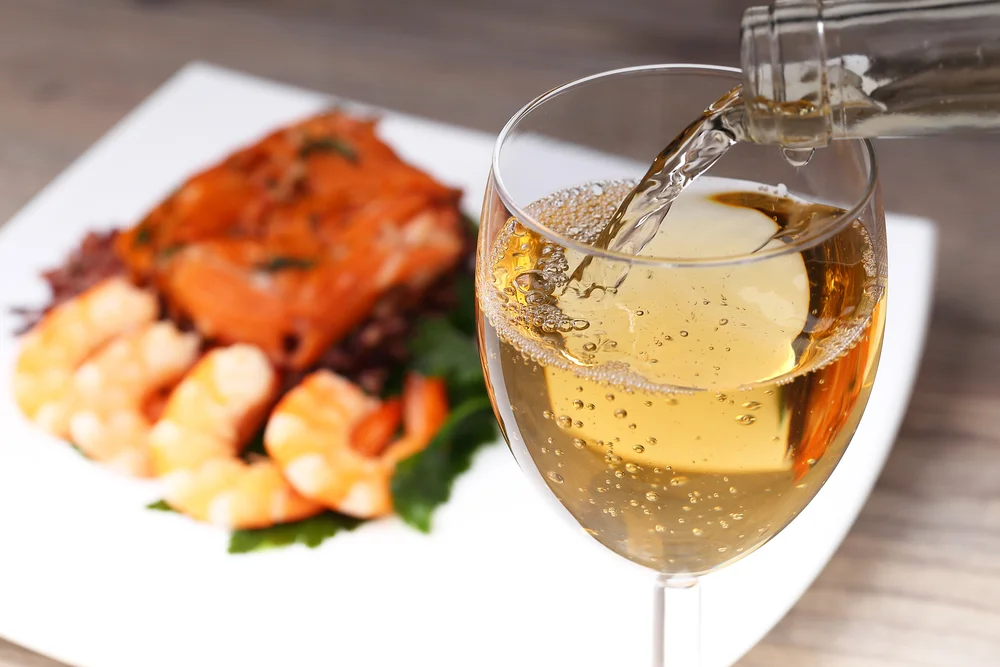
You may also find it works well with pasta dishes and blends well with creamy sauces.
Hint: try pairing Pinot Grigio with mozzarella for the best result.
Sauvignon Blanc’s heartier and more overpowering tastes will often go well with various types of richer and denser foods.
So while you can get a good result with seafood and pasta dishes, you might find that it works best with various types of meats or even spicy foods.
For example, most white meats and goat cheeses blend perfectly with this wine, providing you with a rich array of tastes and flavors.
It may also work as a mix for various types of vinaigrette, typically a milder option without an overpowering or acidic taste.
Sauvignon Blanc is good for those watching their weight, as it tends to be low in calories. That said, Pinot Grigio is also on the low end too. Choose appropriately for your situation.
Pinot Grigio Flavor Notes vs Sauvignon Blanc Flavor Notes
When trying these two wines for the first time, you’re not likely to mistake one for the other.
Simply put, Pinot Grigio and Sauvignon Blanc wines taste very different.
Unfortunately, those tasting profiles are so diverse that it is often hard to compare the two, and some may enjoy one without another.
First, Pinot Grigio is the subtler of the two and typically has a softer taste that is relatively easy to enjoy.
You’ll usually get some light citrus notes, including peach or green apple flavors, with Pinot. Finally, there’s a slightly acidic punch to this wine type depending on where it was grown.
By contrast, Sauvignon Blanc is like a slap to the face with its intensity and overall flavor.
First-time wine drinkers may find themselves overwhelmed by this wine’s lime, peach, grapefruit, and lime undertones.
However, long-term wine fans love this complex hue and will probably pick Sauvignon Blanc over Pinot Grigio.
That said, these tastes will vary based on where the grapes were grown.
For instance, a Sauvignon or Pinot grown in France will have an earthier taste, while New Zealand typically has a fruity flavor.
So make sure you investigate where your grapes originated before buying a bottle.
Deeper Dive: Chardonnay vs. Sauvignon Blanc
As the most consumed white wine globally, Chardonnay may be a bit hard for Sauvignon Blanc to compete against at first.
Its fairly dry and fruity flavors work well for many people’s taste preferences and shouldn’t be hard to fit into most homes.
However, Sauvignon Blanc does many great things, too, that help makes it a more challenging choice between these two than you might think at first.
Chardonnay Grapes Compared to Sauvignon Blanc Grapes
One of the most interesting things about these two wines, are that their grapes are usually quite hard to tell apart, unless you’re an expert winemaker or grower.
But, first, they both originate from France (like many wine grapes) and have a round and green look that grows in tight clusters on the vine.
Sauvignon Blanc grapes grow in slightly looser clusters than Chardonnay grapes and mostly come from Bordeaux, a ubiquitous grape growing region in France.
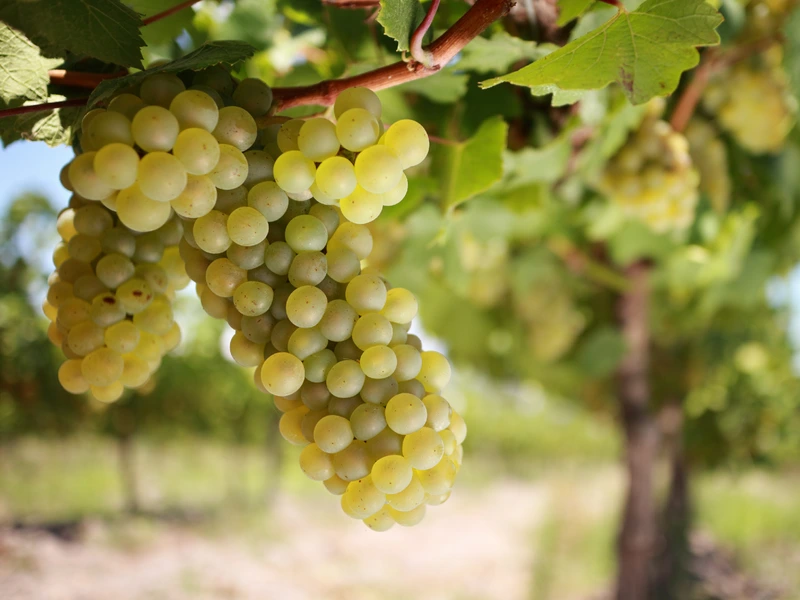
By contrast, Chardonnay grapes grow in much tighter clusters and come mainly from Burgundy in France.
While we’ll talk more about these different regions later, it is also essential to know that Sauvignon Blanc grapes are typically used for white wines and little else.
By contrast, Chardonnay grapes may produce sparkling wines and even champagne when grown properly.
Chardonnay Region vs Sauvignon Blanc Region
The popularity of both of these wines makes them widespread through many growing regions.
For example, both are grown heavily in France, New Zealand, Australia, California, and South Africa. As a result, they often have similar soil and temperature growing conditions.
This fact is important because warmer temperatures bring out different tastes within the wine, as we mention in the taste profile section.
Typically, you get a more rounded flavor with warmer region wines, as well as a slightly drier taste because the grape matures faster and possesses a little less sugar.
There are still a few different growing regions that may specialize in these different grapes.
For example, Sauvignon Blanc is more prevalent in South America and often thrives in the rich soils of Chile and other countries.
By contrast, Chardonnay is commonly grown in North America, mainly through Canada and cooler American growing regions.
Chardonnay Food Pairings vs. Sauvignon Blanc Food Pairings
Pairing foods with wine is something of an art form.
You need to have a pretty good feel for what a wine offers to ensure that you get the best results. However, even people who have never tried wines can successfully pair wines if they know what they are doing.
First, Chardonnay is probably the easier of the two wines to pair with foods because it typically has a fuller body and a subtler taste.
You should find it goes well with various creamy soups and sauces, particularly when paired with rich fish, and many types of high-quality soft cheeses.
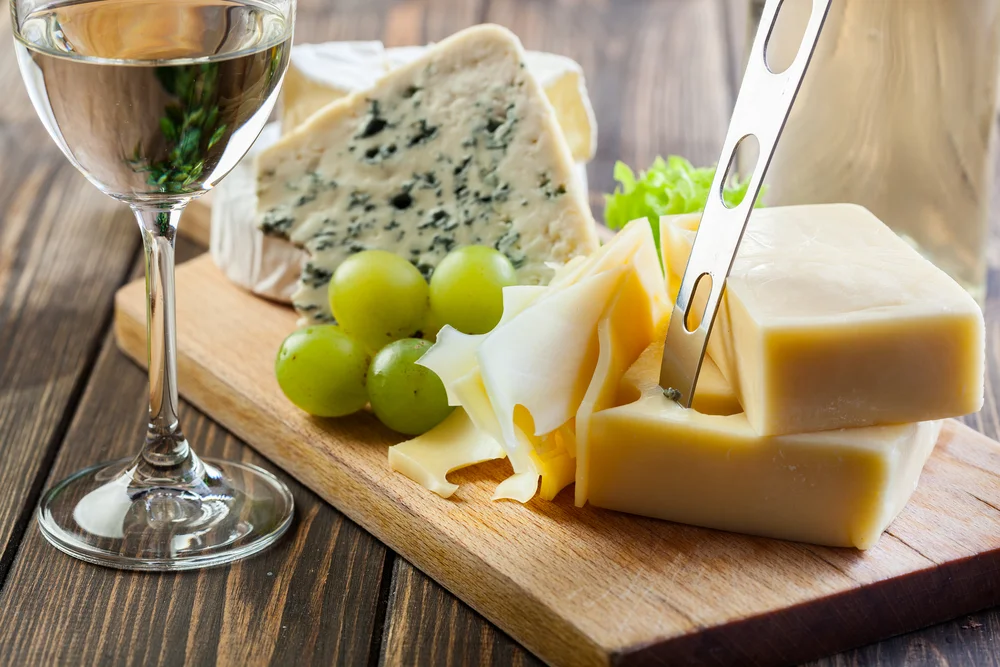
By comparison, Sauvignon Blanc may be harder to pair with some foods.
Typically, you want to avoid anything creamy or too dense in flavor.
Instead, you might find it pairs best with herb-based foods or various types of meats like poultry or fish.
Likewise, citrusy tastes, such as veggies, often blends best with this wine.
Thankfully, both should pair well with some seafood dishes or richer meat blends. It all depends on your personal preference on some level.
However, the generally more potent Sauvignon Blanc requires a bit more of a balanced approach to minimize getting overwhelmed.
Chardonnay Flavor Notes vs. Sauvignon Blanc Flavor Notes
While both Chardonnay and Sauvignon Blanc look reasonably similar in the bottle, the taste couldn’t be more different.
Chardonnay possesses a full-bodied texture that creates a fairly dense taste when in the mouth. Many people love this thicker flavor profile and prefer it over Sauvignon Blanc.
By comparison, Sauvignon Blanc has a more acidic and herbaceous taste with a lighter profile.
They’re both fairly dry, though Sauvignon Blancs do have a sweeter overall taste. That could make them an easier option for some people, particularly those used to sherries or other dessert wine options.
As for notes, expect apple, plums, and pear tastes from your Chardonnay. That should be a good blend for people who like a slightly nuttier and fruitier wine.
As for Sauvignon Blanc, you can expect a little green apple, green bell pepper, gooseberry, and asparagus taste.
Depending on the region, though, you may get some tastes of banana, fig, melon, or mango from your Chardonnays.
The same is truer of Sauvignon Blanc, which develops pineapple, peach, and passion fruit tastes when grown in warmer areas.
Research the grape growing region before purchasing to get the best results.
Which Of These 3 White Wines Is Right For Me?
When deciding between these three white wines, it is vital to consider a few things.
First, how much experience do you have with white wine? If you don’t know much about these drinks, you should probably go with Pinot Grigio, a milder and less overwhelming option.
If you have more experience and feel comfortable upgrading, try a Chardonnay and then a Sauvignon Blanc.
By working your way up to these different options, you should find it easier to pick one that feels comfortable for you without costing a lot of money in the purchasing process. You may also be interested in checking out wine clubs that are affordable, after you become more familiar.
Next, you need to consider what taste notes work the best for your preferences.
For example, a lightly oaked Sauvignon Blanc is often a great “next-level” wine option. However, it would help to consider the growing region, as American Sauvignon Blancs often have more of a citrus flavor or kick to them.
If confused, we strongly recommend going to a nearby winery and doing a taste test of a few of these options.
Most white winemakers will have multiple choices you can pick, which should help you narrow down which of these three wines feels the best for your drinking needs. Cheers!
- Shrimp Cocktail (and More) Wine Pairing Guide - 09/06/2022
- What Wine Serving Sizes Look Like: Standard Size and More - 08/06/2022
- How Much Sugar is in Wine: Glass and Bottle Sugar Content - 08/06/2022

